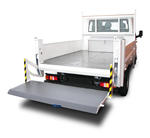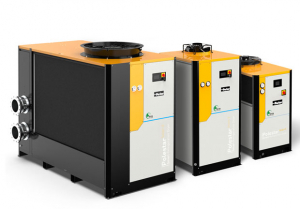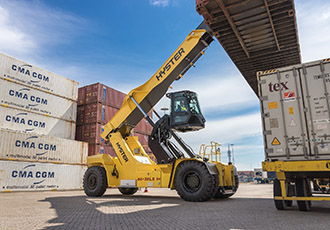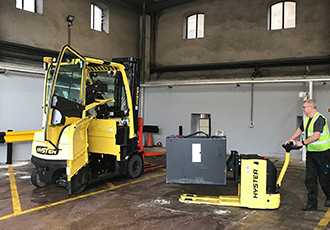PUTTING LOAD HANDLING SAFETY INTO PROPORTION
21st July 2011
Source:
Penny Hydraulics Ltd

Thirty one percent of all fatal, serious and over-three-day injuries reported by the HSE for the year ending April 2010 were related to manual handling. A further 30% were caused by slips, trips and falls on the same level and 9% to falls from any height.
These represent the first, second and fourth largest categories in the HSE’s figures and equate to more than 80,000 people whose lives were directly affected. Countless more family members, friends, colleagues and employers will have also been involved. These figures make stark reading and once again highlight the importance of health and safety in the workplace.
It is tempting to be complacent and believe that “it couldn’t happen here”. But there is another way of looking at these figures - the most likely accident or injury in any workplace will be in these categories rather than some of those that have historically been taken far more seriously.
Often the simplest way to reduce the risk of an accident and resulting injury is to remove the potential cause. That means, for example, eliminating the need for manual handling by providing employees with crane or platform lift on their vehicles or a goods lift in the workplace. This has clear implications for handling, of course, but will also help reduce the risk of slips, trips and falls because many of these accidents occur as a result of people climbing onto a vehicle or up a ladder when load handling equipment would remove the need.
Handling equipment suppliers such as Penny Hydraulics continue to play their part by adding new features to their products that promote safety and make it easier for operators to specify and install them.
There is a trend in crane manufacture to incorporate full hydraulic control for all but the lightest units. Hydraulic control of boom lifting and lowering as well as slew (sideways movement) and rotation helps ensure smooth and precise load handling with reduced risk of the sudden and unexpected movements that can cause accidents to users and bystanders. These features are now widely available on cranes with maximum working load as low as 500kg. The use of proportional controls, another recent innovation on smaller cranes, helps to ensure movements follow the amount the levers are depressed which promotes even greater precision and safety.
Remote controls are also increasingly popular with operators. These are especially useful from a safety point of view because they reduce the need for operators to climb on their vehicles. Instead they stand well away from the vehicle and load when handling is in progress. In general, two types of control are available. The first is attached to the crane or platform lift by a length of cable known as a wander lead while the second is a wireless device that provides the user with complete autonomy to stand in any position with the best all-round view of the working area.
Another aspect of crane and platform lift design is the drive to take out weight without compromising on performance and safety. During the last year or so Penny Hydraulics has used its advanced CAD and finite element analysis tools to re-engineer its crane and platform lift ranges to reduce weight through optimised design and use of alternative materials which replace some steel components with lighter alloys. Operators can now install one of these devices with reduced impact on the overall vehicle weight to leave more carrying capacity for improved operational flexibility and productivity.
It is tempting to be complacent and believe that “it couldn’t happen here”. But there is another way of looking at these figures - the most likely accident or injury in any workplace will be in these categories rather than some of those that have historically been taken far more seriously.
Often the simplest way to reduce the risk of an accident and resulting injury is to remove the potential cause. That means, for example, eliminating the need for manual handling by providing employees with crane or platform lift on their vehicles or a goods lift in the workplace. This has clear implications for handling, of course, but will also help reduce the risk of slips, trips and falls because many of these accidents occur as a result of people climbing onto a vehicle or up a ladder when load handling equipment would remove the need.
Handling equipment suppliers such as Penny Hydraulics continue to play their part by adding new features to their products that promote safety and make it easier for operators to specify and install them.
There is a trend in crane manufacture to incorporate full hydraulic control for all but the lightest units. Hydraulic control of boom lifting and lowering as well as slew (sideways movement) and rotation helps ensure smooth and precise load handling with reduced risk of the sudden and unexpected movements that can cause accidents to users and bystanders. These features are now widely available on cranes with maximum working load as low as 500kg. The use of proportional controls, another recent innovation on smaller cranes, helps to ensure movements follow the amount the levers are depressed which promotes even greater precision and safety.
Remote controls are also increasingly popular with operators. These are especially useful from a safety point of view because they reduce the need for operators to climb on their vehicles. Instead they stand well away from the vehicle and load when handling is in progress. In general, two types of control are available. The first is attached to the crane or platform lift by a length of cable known as a wander lead while the second is a wireless device that provides the user with complete autonomy to stand in any position with the best all-round view of the working area.
Another aspect of crane and platform lift design is the drive to take out weight without compromising on performance and safety. During the last year or so Penny Hydraulics has used its advanced CAD and finite element analysis tools to re-engineer its crane and platform lift ranges to reduce weight through optimised design and use of alternative materials which replace some steel components with lighter alloys. Operators can now install one of these devices with reduced impact on the overall vehicle weight to leave more carrying capacity for improved operational flexibility and productivity.
Similar articles
More from Penny Hydraulics Ltd
- Highway safety improved as companies unite together 19th April 2017
- Chandelier maintenance swings into Birmingham Cathedral 22nd November 2016
- Engineers needed to make sure UK stays ahead of competitors 20th July 2016
- Penny Hydraulics new crane range makes light work of heavy lifting 12th March 2015




.jpg)







Write a comment
No comments